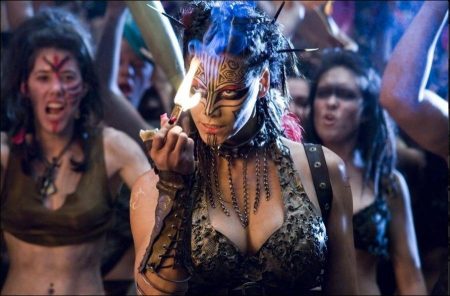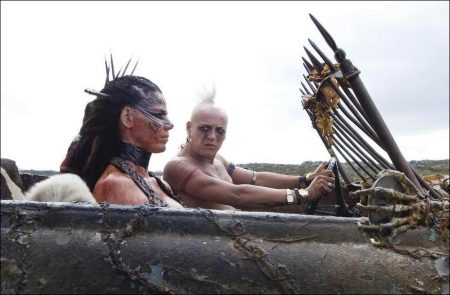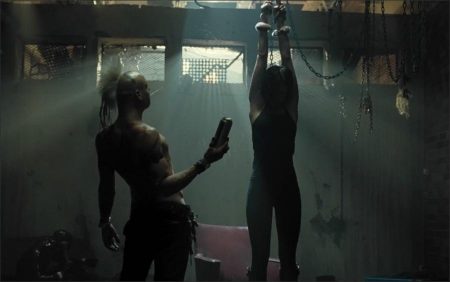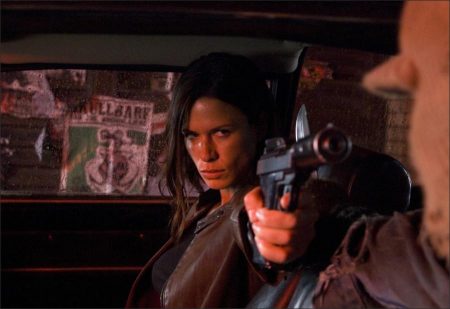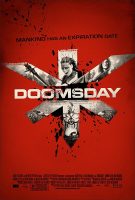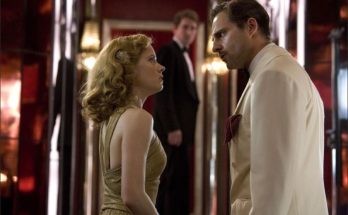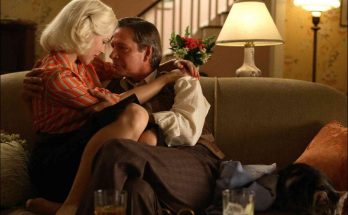Envisioning the Future
Comparing the scale of DOOMSDAY with his previous feature films, Marshall explains, “My last two films were both essentially a small group of people in a very contained environment. The biggest crowd scene was perhaps 20 extras, whereas on DOOMSDAY, we were going to need 50 extras on the first day and almost 1,000 in later scenes. We were going to have to shoot in a range of locations—streets, forests, mountains, castles and inside ships. I wanted to work on a huge scale, what I’ve done before. It seemed daunting at the outset, but I knew it was going to be a huge adventure.”
To realize this ambitious adventure, Marshall chose to work with many of those with whom he collaborated on previous projects, including director of photography Sam McCurdy, production designer Simon Bowles and prosthetics makeup designer Paul Hyett. The filmmaker explains: “I like working with my mates, and they bring something fresh to each film that we do together. We have good camaraderie on set, which spreads to the rest of the cast and crew. It’s been a growing-up process for all of us, a challenge. Simon has built wonderful sets, Sam makes everything look fantastic and Paul never lets me down when I need more gore.”
Together, the creative team has synced on its “Marshall Style”: “If I have any kind of visual style, it’s that I like to do as much as possible in-camera; it’s something I picked up from Ridley Scott,” the director notes. “Although we were going to use some visual effects on DOOMSDAY, I don’t ever want to rely on them. I like things to look raw. If someone is going to be hit by an axe, I don’t shy away from the aftermath. If there is a fall, someone will get hurt, not stand up and walk away. I want it to look as realistic and brutal as it should. I think practical effects stand the test of time, where visual effects are being refined and can end up looking really dated.”
Months before principal photography began, filmmakers ordered up concept paintings, to discuss and modify how the scenes might look. The director utilized his customary storyboards on every scene, particularly the action sequences. However, once shooting began, these paintings and storyboards were never referenced, as Marshall wanted to remain open to new ways of capturing a scene on film, as well as allow the actors to move within the locations as motivated by character.
(Interestingly, after the film had wrapped, Marshall reviewed the early concept art and found that his departments had more than delivered, as those pre-shoot looks had been either matched or topped by his creative crew.)
DOOMSDAY’s shooting would take place primarily in South Africa, where the varied and plentiful location possibilities—both structural and landscape—would stretch production dollars that would ordinarily be spent on expensive set construction. Not to mention the weather…as principal photography was slated for a January start date, the high summer weather would prove a boon to the large, outdoor scenes conjured in Marshall’s script. Following the 66-day shoot there, production pulled up stakes and hightailed it to the U.K., for two weeks of filming in Scotland and the lensing of one very special location in London (what would a film set in the U.K. be without an iconic shot of the London Bridge?).
In South Africa, production was headquartered in Cape Town, which proved to be governed by a cooperative bunch. Marshall offers, “Shooting DOOMSDAY in Cape Town was an adventure in an amazing landscape. The crew was awesome. The locations were spectacular. The weather was incredible. We exploded countless pyros in the center of Cape Town in the middle of the night. We closed down the city center on a Saturday afternoon to stage a frantic foot/bus/motorbike chase. We took over a major theme park, dressed it as the villains’ lair and filled it with a thousand screaming extras—waving baseball bats, hanging from the rafters and generally baying for blood. They had a lot of fun that night, and so did we.”
On location in South Africa, the production was also permitted to use Cape Town City Hall as the exterior of St. Andrew’s Hospital Glasgow, where Sinclair’s team arrives in its armored vehicles to explore. The hospital they find is long abandoned and covered in weeds, with broken windows and shells of cars clogging the roads outside. Working by night, the building was dressed with foliage and burned-out automobiles. The onlookers may have been surprised to see the same balcony where Nelson Mandela addressed the crowd on his release from prison transformed into deserted wasteland. (Strangely, no one seemed to notice when production began to set off Molotov cocktails at 4 a.m.)
According to Marshall, the cycling in of new filmmaking talent is something that benefits both director and cast: “There was a great spirit on set, and I think that feeds into the energy of the actors, too. I don’t believe in the auteur theory, as I bring people in to collaborate with them. I give them freedom because I want their input. It’s pointless employing people if you continually reject their ideas, and that applies to actors and crews. My job is not to deny people their say, but to filter that input and decide whether it works for the film or it doesn’t.”
This synergy resulted in a realized vision that impressed even the film’s producer. Says Benedict Carver, “The production design has been fantastic. We’ve been a location-driven film. We haven’t built that many sets, but the sets that we have built have been really fantastic—mainly our command center, which we built in South Africa. We’ve had to dress a lot of sets, and I think we’ve really done a great job there—distressing things, making things look rundown, transforming locations— so that they fit in with the look of the film.”
Production designer Simon Bowles elaborates on the theories that lay behind the world of DOOMSDAY, basically incorporating five distinctly different time zones into one. He notes, “We start in present-day Scotland, where the virus has taken hold and the wall is being closed to contain it. Then, we jump forward to London 25 years later, which is cut off from a world which fears the virus will spread. London has two societies: the very poor police state, and the futuristic warriors who control it. We revisit Scotland and see the Marauders’ world, a renegade outpost where they’ve used everything abandoned and broken-down to make new things for themselves, particularly weapons and cars. And then we travel to Kane’s castle, where the survivors have retreated into a modern version of medieval life—they look as if they’ve raided museums. All these scenes have different looks and different people…the huge challenge is when those different worlds collide and mingle.”
One of the film’s biggest set pieces is the surreal rally orchestrated by the leader of the pissed-off punk survivors, Sol. Marshall enthuses, “The scene I expected to be most challenging was the action at Sol’s headquarters, with hundreds of Marauders, fire eaters, trapeze artists, bikers and Craig Conway as Sol, living out the ultimate rock-star dream, stoking the crowd into a frenzy. It ends up with Sean Pertwee [as Talbot] being barbecued live onstage and then devoured by the crowd. In fact, it was great fun, and one of the easiest scenes to shoot, once we had worked out the logistics.”
Marshall continues, describing the circus from hell: “Onstage, we had a floorshow of pole dancers and a group of fat guys dressed in kilts doing the can-can. All this was going on behind Sol, who is egging on 800 of his followers to the big finale. Craig Conway loved playing the rock god, leading his Marauders, but I think Sean Pertwee was a bit taken aback by the scale of the scene when he was wheeled in as the human sacrifice. Simon Bowles had created a vehicle called the Griller Killer, with Sean suspended on a crane arm and lowered down over flames. As he is being roasted alive, the crowd lines up, plates in hand, ready for the dole out of his flesh. In the end, Sean was chuffed, because he definitely has the most spectacular death scene. No one has seen anything like this on film before!”
What was dreaded ended up delighting all who participated—if a flambéed human for dinner can delight anyone. Designer Bowles filled the amazing set with wrecked cars, skulls, metal sculptures, graffiti and old furniture. The hundreds of extras all looked the part of a mad crowd that grew up behind the wall (think of the boys in Lord of the Flies two decades later), each with individualized makeup, hair and wardrobe. The result is an insane mix of Moulin Rouge! and The Wicker Man.
Another scene high on the list of challenges was the sequence in which the wall between Scotland and England is sealed, abandoning the northern population to certain death by Reaper virus. Creating a modern version of Hadrian’s Wall, the art department built a 300-foot-long, 30-foot-high portion of wall across a country road, using an ingeniously easy assembly system Bowles found, which uses temporary metal casing into which concrete is poured and left to dry. The resulting panels, when joined, look like something the British government (25 years hence) might have on hand for emergency use…just in case it needed to block off anything virulent. The designer added corrugated iron casing to give the wall a more solid look on film.
The sequence was shot over three nights and involved hundreds of extras (as desperate civilians trying to escape from Scotland while soldiers hold them back), cars in a long roadblock at the border, army vehicles and a helicopter in which the young Eden Sinclair is lifted to safety. Says Marshall, “The extras had to cause a riot and run at the wall at the same time as our special effects were firing squibs for gunfire. It was difficult and potentially dangerous, but our stunt people did a great job choreographing the whole thing.”
As an inside joke, production included a group of Hare Krishna followers as extras, reasoning that they pop up everywhere one goes. They worked so well that the director kept them throughout the sequence, with them appearing in all of the major action scenes. At the end of their stint filming, the Krishnas presented Marshall with a Spiritual Warrior book and declared him an honorary member of their Hare Krishna group.
Just as the team may have thought that their biggest challenges lay behind them, it was time to stage DOOMSDAY’s breathless car chase, pitting a Bentley-driving Sinclair and her remaining associates against the Marauders—who were driving a variety of eccentric vehicles, including old buses, police cars and motorbikes, all fashioned out of something else. Says Marshall, “We used 10 cameras on the scene. I’d never seen 10 cameras together before. The car chase is part Bullitt, part Mad Max, but mostly Neil Marshall.”
The last three weeks of South African shooting were spent entirely on the chase. This established a record for Marshall as the longest ever spent filming a single sequence, with each day of shooting featuring at least one or two dangerous stunts or pyrotechnics. Although the production did see a few close calls, luckily no one was injured during filming.
One of designer Bowles’ favorite props was Sol’s car. He explains, “We took a beautiful classic Jaguar and covered it in human skin, badly sewn together and stretched, with faces looking out of the surface and skeletal hands holding mirrors and accessories. It illustrates how cheaply life is regarded in his world.”
Clearly, with all of this action being planned, the cast needed to be game for almost anything, particularly Mitra, whose character of Sinclair is rarely off-screen. Just as production relied on a pre-shoot prep period to ready for the filming ahead, Mitra spent three months prior to shooting inside a gym working on fight choreography, as well as in driving and stunt training, along with physical strength and endurance work. By the time Sinclair appeared in her first scene, Mitra was in peak form.
As the stunt coordinator on DOOMSDAY, Cordell McQueen—whose extensive resume also lists credits as special effects supervisor—was responsible for all of the Herculean physical acts contained in the script. For Cordell, the physical training was the easy part…exploding, flipping, destroying and any other “wow factor” from Marshall’s mind equalled the times where things could get tricky. He explains, “We had a special fitness program for Rhona, which she continued throughout the shoot. We had to be careful during filming that she didn’t tire herself out. For me, though, one of the most challenging scenes was crashing the APC [the two specially-built, armored all-terrain vehicles], because we didn’t have a test vehicle to work on. So we constructed scale models of the APC to try and figure out the right-sized ramp to flip it. It was a big chunk of steel that weighed about eightand- a-half tons, so it was going to be a feat. That stunt involved the longest thought process, and it worked out perfectly in the end.”
In May, production pulled up stakes for Glasgow, Scotland, to film highland scenes, including Mitra’s most physically challenging sequence. The gladiatorial battle against Telemon, Kane’s champion, was brought to life with South African karate champion/towering physical giant Hennie Bosmana. Described by Marshall as a David and Goliath situation, Sinclair manages to outwit the enormous fighting machine by using his own strength against him. “It’s basically an execution, or trial by combat,” the director explains, “but dragged out in an arena to entertain Kane’s people. In Medieval-land, they like a bit of gratuitous violence. It was the last scene we shot there.”
For the sequence, Mitra called upon her muses: “I think actors who do action well try to add a little bit of flavor, sometimes, because it’s a serious matter we’re dealing with. And Neil tries to put in a little bit of a ‘wink and a wiggle,’ as I call it. Harrison Ford has a good wink and a wiggle in serious moments. And, of course, Mel Gibson does. On the other side, Sigourney Weaver plays it straight as anything. So, those were my sources…you know, little angels and devils on my shoulders.”
The location for this epic battle was Blackness Castle, on the Firth of Forth on the east coast of Scotland. First built as a stronghold in the 15th century, the stern grey building juts into the water at the mouth of the river Forth. Although not far from Edinburgh, the Castle looks bleak and remote enough to stand in as Kane’s headquarters, where he and his people have retreated from the world that left them to die.
The finale of this sequence involves an explosion ripping through the structure, and Marshall recalls, “I remember our Irish FX supervisor had a very charming and cool way about him. Rather than be all gung-ho and cue the explosion with a loud ‘Green for go!’ or ‘Hit it!,’ he simply and calmly spoke to the man with his finger on the button and said, ‘Blow up the castle.’ It was the perfect way to end the shoot. We wrapped right on schedule and under budget.”
Producer Carver praises, “We were thrilled to be shooting in Scotland; we have had a great relationship and a lot of help from Scottish Screen, and also from Historic Scotland and the Glasgow Film Office. Their help basically enabled us to film there.”
It probably goes without saying that a death from the Reaper is anything but poetic. To help concoct the mother of all viruses, Marshall again looked to designer Paul Hyett, who provided prosthetic make-up for The Descent, most notably creating the look of the terrifying and slimy Crawlers. Hyett worked on all the prosthetics throughout DOOMSDAY’s shoot, viral and otherwise, which involved gallons of blood (as characters were pole-axed, beheaded and run over by tanks, and also when extremities such as limbs and heads needed removing).
The Reaper virus makeup debuted on the first day of shooting, in a presentday scene in which the alpha patient—Patient X—shows symptoms and is taken to a London hospital, alerting the authorities that the virus has reappeared in the capital. Says Hyett, “Neil’s instructions were, ‘It’s got to look as nasty as possible. We want to feel that if one of these guys coughed on you, you’d be dead!’ I explored the topical symptoms of many diseases, mainly fungal infections and venereal diseases. You can find all kinds of truly horrid skin disorders on the net these days!”
Then, Hyett executed various test looks for camera, so that Marshall could choose the one he thought appeared most unsightly on screen. After due consideration, he chose them all, charging Hyett to incorporate all of the various pustules, rashes, sores and boils into one super look for the Reaper. The team worked especially hard to make sure that no disgusting details were overlooked, including the appearance of the eyes (“One thing that is often ignored,” states Hyett). The eyes were “pulled down” so that it looks as if the infection causes the gradual loss of the eyelid, with the eye itself showing through. Contact lenses were added for a yellowing effect.
Makeup and hair designer Tahira Herold comments, “My favorite moment of the shoot was the first night that we had the Marauders out. Neil pulled me over—I expected a note to tweak something, change this or alter that, because the scene was filming in two days. But what he said was, ‘They look fantastic. Thank you so much!’ And I sort of kept my composure and then ran to my team and jumped up and down—we had this little celebration moment, because I was just so proud of what we had done. It was amazing. The Marauders, led by Sol and Viper, their whole look was such an amalgamation of tribal influences—everything from the punks of the ’70s to the really cool-cat kids today. And we had nailed it.”
Marshall was surprised when Hyett pointed out that DOOMSDAY features more blood and guts than their previous collaboration. “Paul told me the difference is that the gore in this film is more evenly spread—it’s not all in the last half-hour,” he states. “We haven’t made a horror film, but I suppose I can’t resist splashing the blood around.”
Such a rough-and-tumble shoot was bound to leave its effect on both cast and crew. After all, they had logged innumerable hours (and countless frequent flier miles) to create a bizarre and brutal look into a near future in which our existence is threatened by a horrific virus that aims to do what no human has been able to accomplish—dominate the globe.
Star Rhona Mitra came away with some cravings, plus a form of communication nonexistent to the stoic Major Eden Sinclair: “I have my nieces and nephews that I want to go and get cuddles from. I need cuddles,” she laughs. “You know, I didn’t have one break. So, it’s time for little babies and stuff. I need to go and see my dogs. And I really want to eat. I want a burger. And to go by my favorite fish and chips shop.”
And on the downside? “If somebody upsets me, my knee-jerk reaction is to punch, elbow or head butt them. I’ll have to keep that in check.”
Neil Marshall concludes with what he hopes for DOOMSDAY: “Although it’s almost like a journey through time, there is no actual time travel involved. These very different worlds exist all in the same time frame. At the end of the day, I hope that audiences get an incredible thrill ride, a journey of the imagination.”
Doomsday (2008)
Directed by: Neil Marshall
Starring: Rhona Mitra, Bob Hoskins, Alexander Siddig, Adrian Lester, Sean Pertwee, Darren Morfitt, Emma Cleasby, Chris Robson, MyAnna Buring, Rhona Mitra, Christine Tomlinson
Screenplay by: Neil Marshall
Production Design by: Simon Bowles
Cinematography by: Sam McCurdy
Film Editing by: Andrew MacRitchie, Neil Marshall
Costume Design by: John Norster
Set Decoration by: Mark Auret, Zoe Smith
Art Direction by: Steve Carter, Susan Collin, David Doran, Jonathan Hely-Hutchinson, Mags Horspool, Rhian Nicholas, Emer O’Sullivan, Andy Thomson, John Trafford
Music by: Tyler Bates
MPAA Rating: R for rong bloody violence, language and some sexual content / nudity.
Distributed by: Universal Pictures
Release Date: March 14, 2008
Visits: 217
